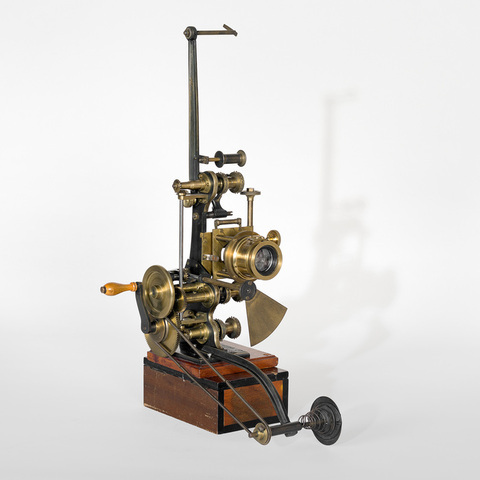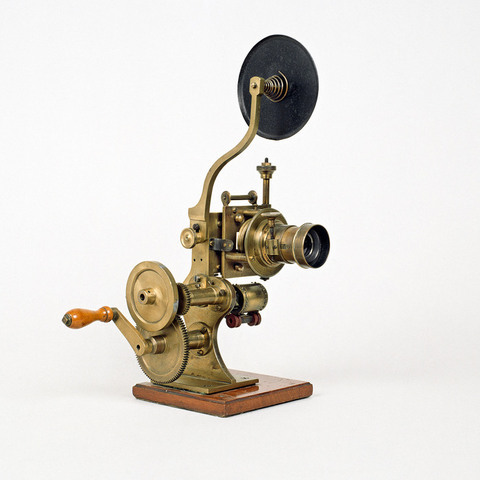Projecteur de film 35 mm
Fiche détaillée
Type de l'appareil
entraînement du film 35 mm par croix de Malte à cinq branches ; trois débiteurs dentés ; obturateur avant une pale ; bras débiteur et bras récepteur ; objectif à crémaillère ; manivelle ; réglage fenêtre ; volant ; base en bois
Auteurs
Informations non disponibles
Fabricants
Levi, Jones & Co LTD
Londres, 71 Farringdon Road
Utilisateurs
Informations non disponibles
Distributeurs
Elie Xavier Mazo
Paris, 10 bd Magenta
Sujet du modèle
Informations non disponibles
Objectif
3,5 cm diamètre
Taille de l'objet
Ouvert :
Informations non disponibles
Fermé :
Longueur : 31 cm
Largeur : 24 cm
Hauteur : 55 cm
Diamètre :
Informations non disponibles
Taille de la boîte de transport
Informations non disponibles
Remarques
A partir de 1900, Mazo vend le projecteur anglais Cynnagraph de Levi, Jones & Co. En 1906 apparaît cette version, pourvue de deux bras et de deux débiteurs supplémentaires, permettant l'utilisation de bobines de 200 m. La structure du projecteur reste identique. L'appareil est encore au catalogue Mazo en 1913.
"This instrument is a simplified form of apparatus for exhibiting animated photographs, and certainly the wholesale firm (Messrs. Joseph Levi & Co., 97 Hatton Garden, E.C.), introducing it should make a hit. It is, we learn, to retail for £ 5,5 s. The spocket wheel is rotated by mechanism geared to what is known as the star wheel movement, which works with great certainly and regularity. In point of size the instrument is small, and can be packed up into a box 5 1/2 by 5 1/2 inches. The spool containing the film may be instantly removed when desired, yet in the ordinary course there is absolutely no chance of its coming off, as it were, by accident. One of the sides of the holder is made to screw off, thus enabling the film to be taken quickly off the winder and placed away, and as for changing the film, it is a very simple matter" (Optical Magic Lantern Journal and Photographic Enlarger, octobre 1898, p. 138).
"Levi, Jones & Co. Ltd, who the previous year had introduced the French Rollograph on the English market, now in 1898, issued two further machines, the Matagraph and the Cynnagraph. The former was a well-made projector selling at £6 and was reputed to be one of the cheapest on the market. It may have been first introduced towards the end of 1897, but the earliest reference to it I have found, is dated 25 February 1898, by which time 200 of the machines had already been sold. During the course of its existence, the projector was constantly being improved and at least four different models are known. What may be the earliest form of the apparatus is preserved in the Barnes collection, but unhappily, in an incomplete state. It consists of a polished mahogany case with a hinged door at the front giving access to the mechanism inside. Two hinged doors, or flaps, open out at the top to support a metal hanger on which the roll of film is placed. The film is then fed through the machine and avanced by a single sprocket-wheel which has an intermittent movement applied to it by a Maltese-cross. The film finally issues through a hole in the bottom of the case and presumably falls into a suitable receptacle underneath, as no take-up spool is provided. A crank-wheel turns on a fixed spindle on one side of the case and is connected by a crossed band to a pulley on the main driving shaft. A flatt brass plate, pivoted at one corner, is attached to the back of the case to act as a safety shutter or light cut-off. Immediately behind the gate is a small two bladed shutter which revolves like an ordinary barrel-type shutter, but in this case the blades are flat and not curved. A description of the apparatus in "Photography Annual for 1898", tells us : "The lantern body is of Russian iron with cowl and tray for jet, and fitted with 4in compound condenser. It is arranged so as to slide along the baseboard for adjustment. The lens is a double achromatic Petzval combination of 2,5 in focus, and at 28 ft. will project a picture 10 ft x 7 ft 6 in. The whole instrument is fitted into a stout case, with lock and key and handle, and T screws with bushes are issued to permit the Matagraph to be fixed on to the top of its case". Later in the year, the Matagraph was much improved and the price was increased to twelve guineas (£12.60). It will be observed that by a single deplacement of the film projector, slides are well as films could be shown. In this newer model, the light cut-off was improved and provision was made for a larger spool of film. We are informed that the nature of the escapement enabled a film to be reversed simply by cranking the handle in the opposite direction. Reverse action could thus be shown without the need for a reversing prism. A Matagraph projector in the Science Museum differs [...] : it should be noted that the extra wooden pulley on the driving shaft of the Science Museum example has been added to provide a driving band to the take-up spindle, which unfortunately is missing. The model, although incomplete, resembles somewhat the one shown in a illustration from the "Monthly Supplement" to the "British Journal of Photography", of 3 June 1898. After the introduction of the new regulations passed by the London County Council in November, a special auxiliary safety shutter, which worked automatically, was provided for the Matagraph. It was designed in such a way that it automatically opened and closed immediately the projector was started off stopped. On 19 May Levi, Jones & Co moved from 17 Farringdon Road to more commodious premises at 29 Hoxton Square, Old Street. Having transformed the original cheap form of the Matagraph into a higher class instrument, the firm probably thought there was once again room for a cheaper cinematograph and so the Cynnagraph was launched, probably appearing on the market for the first time in August. The projector could be used with any make of lantern, as well made, and sold for as little as five guineas (£5.25]. Like the Matagraph, it was a single sprocket machine with a Maltese-cross movement. It was even smaller in size, and could be packed away in a box measuring 5,5 x 5,5 x 8 inches. The film was contained in a metal spool box, one side of which was made to screw off so that the film could be quickly and easily changed" (John Barnes, Pioneers of the British Film, London, Bishopsgate press, 1983, p. 105-107).

